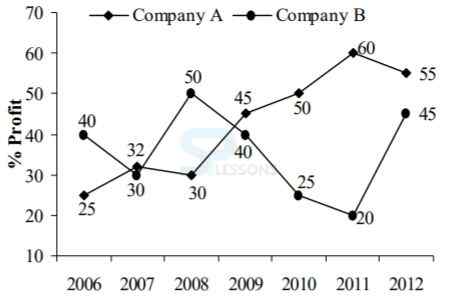 Introduction
Introduction
Employees Provident Fund Organisation (EPFO) has announced a notification for the recruitment of Social Security Assistant Posts. EPFO SSA 2019 Preliminary Exam would be held on 31.08.2019 and 01.09.2019.
The article EPFO SSA Model Paper 1 provides pattern Questions, and it helps the candidates to devise effective preparation strategies, by focusing on their strengths and weaknesses in different topics and also useful to the candidates while preparing Various Insurance, Banking & Government Exams like SBI PO, SBI Clerk, SSC CPO, SSC CHSL.
Preliminary Examination is important to qualify for the Mains Examination. Below mentioned data gives an overview of the EPFO SSA Model Paper 1. The paper is divided into three sections i.e., Reasoning ability, Numerical Aptitude, and English Language.
 Pattern
Pattern
| Name of the Test | Questions | Maximum Marks | Time Duration |
|---|---|---|---|
| English | 30 | 30 | 20 Minutes |
| Reasoning | 35 | 35 | 20 Minutes |
| Numerical Aptitude | 35 | 35 | 20 Minutes |
| Total | 100 | 100 | 60 Minutes |
 Sample
Sample
Directions (Q. 1-5): What approximate value should come in place of question mark (?) in the following questions?
1. 148% of 13785 = ?
1. If the population of city A in the year 2015 was 10,000 then what was its population in the year 2017?
-
A. 20100
B. 20200
C. 20300
D. 20400
E. 20500
-
A. 210
B. 220
C. 230
D. 240
E. 250
-
A. 6180
B. 6280
C. 6380
D. 6480
E. 6580
-
A. 105
B. 125
C. 145
D. 165
E. 185
-
A. 35
B. 45
C. 55
D. 65
E. 75
-
A. 1672
B. 1668
C. 1665
D. 1662
E. 1660
-
A. 28216
B. 28226
C. 28236
D. 28246
E. 28256
-
A. 1450
B. 1460
C. 1470
D. 1480
E. 1490
-
A. 3193
B. 3183
C. 3173
D. 3163
E. 3153
-
A. 4332
B. 4223
C. 4218
D. 4232
E. 4323
-
A. if x > y
B. if x > y
C. if x < y
D. if x < y
E. if x = y or no relationship can be established between ‘x’ and ‘y’.
| City | From 2015 to 2016 | From 2016 to 2017 |
|---|---|---|
| A | -20 | 20 |
| B | 15 | -10 |
| C | 25 | 25 |
| D | -10 | 40 |
| E | 40 | -20 |
-
A. 10400
B. 9600
C. 10600
D. 10200
E. None of these
-
A. 64 : 125
B. 125 : 64
C. 1 : 2
D. 1 : 3
E. None of these
-
A. 42%
B. 33%
C. 35%
D. 39%
E. None of these
-
A. 12%
B. 15%
C. 18%
D. 21%
E. None of these
-
A. 51%
B. 59%
C. 55%
D. 53%
E. None of these
-
A. Rs 1400
B. Rs 1500
C. Rs 1600
D. Rs 1700
E. Rs 1800
-
A. Rs 150
B. Rs 160
C. Rs 180
D. Rs 172
E. Rs 175
-
A. 2640.12 sq m
B. 2735.04 sq m
C. 2831.6 sq m
D. 2942 sq m
E. None of these
-
A. 210
B. 180
C. 120
D. 80
E. 60
-
A.[latex]\frac{147}{665}[/latex]
B.[latex]\frac{518}{665}[/latex]
C.[latex]\frac{54}{455}[/latex]
D.[latex]\frac{44}{455}[/latex]
E.[latex]\frac{401}{455}[/latex]
-
A. 55.55%
B. 80%
C. 120%
D. 180%
E. 300%
-
A. 12 days
B. 13 days
C. 14 days
D. 15 days
E. 16 days
-
A. 8 hours
B. 10 hours
C. 12 hours
D. 16 hours
E. 18 hours
-
A. 7 pm
B. 11 pm
C. 8 pm
D. 10 pm
E. 9 pm
-
A. 400 sq m
B. 441 sq m
C. 484 sq m
D. 529 sq m
E. 576 sq m
-
A. 56 lakh
B. 65 lakh
C. 72.8 lakh
D. 97.64 lakh
E. 113.256 lakh
-
A. 139.18 lakh
B. 148 lakh
C. 138.2 lakh
D. 140.43 lakh
E. 144.64 lakh
-
A. 2007
B. 2009
C. 20010
D. 2011
E. None of these
-
A. 2006
B. 2008
C. 20011
D. 2012
E. None of these
-
A. 48.6 lakh
B. 50.4 lakh
C. 51 lakh
D. 53.2 lakh
E. 57.6 lakh
Directions (Q. 36-40): Study the following information to answer the given questions.
In a certain code language, ‘no lo pe to’ means ‘we love our country’, ‘le pe no ze’ means ‘India is our country’, ‘ko pe ge co’ means ‘proud to be country’, ‘le ko’ means ‘proud India’, ‘ge lo so’ means ‘love to all’ and ‘fo le gm’ means ‘India independence day’.
36. What is the code for ‘independence’?
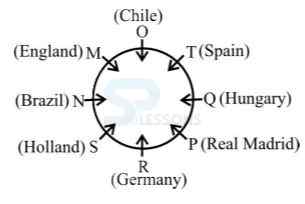 42. Answer: Option E
43. Answer: Option C
44. Answer: Option E
45. Answer: Option A
46. Answer: Option E
Explanation:
Conclusion I is inherent in the first statement.
Again,
All dogs are kittens (A) + No kittens are black (E) = A + E = E = No dog is black
Hence, conclusion II follows.
47. Answer: Option A
Explanation:
There is no negative statement. Hence, Conclusion I follows. But conclusion II is a negative
conclusion. Hence, II does not follow.
48. Answer: Option E
Explanation:
All scholar are eccentric (A) + Conversion of No woman is eccentric conversion No
woman is a scholar.
Hence, conclusion I follows.
Again, All scholars are eccentric (A) + All eccentrics are studies (A) = A + A = A. All scholars
are studies. It means. All studies being scholar is a possibility. Hence, conclusion II follows.
49. Answer: Option C
Explanation:
Some eggs are hard-boiled conversion Some hard-boiled are eggs (I) + No eggs are
uncrackable (E) = I + E = O = Some hard-boiled are not uncrackable.
But, conclusion I and II make a complementary pair (I–E).
50. Answer: Option A
Explanation:
All perfumes are expensive (A) + All expensive things are unique (A) = A + A = All perfumes are unique.
Hence, All unique thing being perfumes is a possibility.
Thus, conclusion I follows. But II does not follow.
51. Answer: Option B
Explanation:
42. Answer: Option E
43. Answer: Option C
44. Answer: Option E
45. Answer: Option A
46. Answer: Option E
Explanation:
Conclusion I is inherent in the first statement.
Again,
All dogs are kittens (A) + No kittens are black (E) = A + E = E = No dog is black
Hence, conclusion II follows.
47. Answer: Option A
Explanation:
There is no negative statement. Hence, Conclusion I follows. But conclusion II is a negative
conclusion. Hence, II does not follow.
48. Answer: Option E
Explanation:
All scholar are eccentric (A) + Conversion of No woman is eccentric conversion No
woman is a scholar.
Hence, conclusion I follows.
Again, All scholars are eccentric (A) + All eccentrics are studies (A) = A + A = A. All scholars
are studies. It means. All studies being scholar is a possibility. Hence, conclusion II follows.
49. Answer: Option C
Explanation:
Some eggs are hard-boiled conversion Some hard-boiled are eggs (I) + No eggs are
uncrackable (E) = I + E = O = Some hard-boiled are not uncrackable.
But, conclusion I and II make a complementary pair (I–E).
50. Answer: Option A
Explanation:
All perfumes are expensive (A) + All expensive things are unique (A) = A + A = All perfumes are unique.
Hence, All unique thing being perfumes is a possibility.
Thus, conclusion I follows. But II does not follow.
51. Answer: Option B
Explanation:
 52. Answer: Option B
Explanation:
Because P lies between the one who scored 97% marks and the one who scored 80% marks.
53. Answer: Option E
54. Answer: Option E
55. Answer: Option E
56. Answer: Option D
Explanation:
52. Answer: Option B
Explanation:
Because P lies between the one who scored 97% marks and the one who scored 80% marks.
53. Answer: Option E
54. Answer: Option E
55. Answer: Option E
56. Answer: Option D
Explanation:
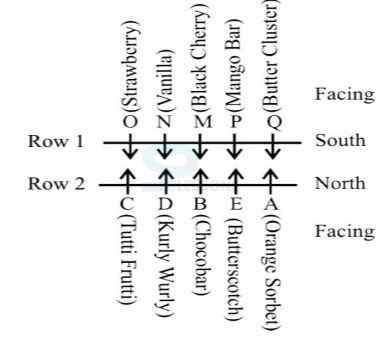 57. Answer: Option B
58. Answer: Option E
59. Answer: Option B
60. Answer: Option C
61. Answer: Option D
Explanation:
From I:
57. Answer: Option B
58. Answer: Option E
59. Answer: Option B
60. Answer: Option C
61. Answer: Option D
Explanation:
From I: From II:
From II: From III. U R E
Now, from I and III. M _ _ U R E
Now, combining this with II (c), we get MANURE.
62. Answer: Option E
Explanation:
Both ‘friends’ and ‘are’ are common to all the statements.
63. Answer: Option E
Explanation:
From I.
From III. U R E
Now, from I and III. M _ _ U R E
Now, combining this with II (c), we get MANURE.
62. Answer: Option E
Explanation:
Both ‘friends’ and ‘are’ are common to all the statements.
63. Answer: Option E
Explanation:
From I.
From II.
O – Black – does not study in VI or III.
From III.
P – Blue – V
Q does not study in III and N does not like Red pen.
From (I), (II) and (III).
Thus, even (I), (II) and (III) together are not sufficient to answer the question.
64. Answer: Option C
Explanation:
From I.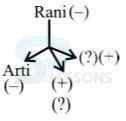 From II.
From II. From III.
From III. 65. Answer: Option D
Explanation:
From I.
65. Answer: Option D
Explanation:
From I.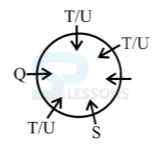 From I and II.
From I and II.
 From (I), (II) and (III).
From (I), (II) and (III).
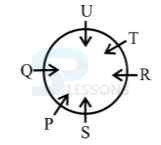 Thus, (I), (II) and (III) are sufficient to answer the question.
66. Answer: Option B
Explanation:
D = T ≥ M < J
From the given expression
D and J cannot be combined. So, I is not true.
From the given expression
D ≥ M. So, II is true.
67. Answer: Option C
Explanation:
8 < K = N ≥ R
From the given expression
R = K
Which means either I (R = K)
or II (R < K) is true.
68. Answer: Option A
Explanation:
Given, H ≥ F So, I is true.
From the given expression,
We cannot compare H and W. Thus, II is not true.
69. Answer: Option D
Explanation:
Given, Z > D ≤ K > M
From the given expression,
M and D cannot be compared. Thus, I is not true.
From the given expression,
Z and K cannot be compared. Thus, II is also not true.
70. Answer: Option E
Explanation:
Given, W ≤ B ≤N Thus, I is true.
From the given expression,
W < N. Thus, II is also true.
Thus, (I), (II) and (III) are sufficient to answer the question.
66. Answer: Option B
Explanation:
D = T ≥ M < J
From the given expression
D and J cannot be combined. So, I is not true.
From the given expression
D ≥ M. So, II is true.
67. Answer: Option C
Explanation:
8 < K = N ≥ R
From the given expression
R = K
Which means either I (R = K)
or II (R < K) is true.
68. Answer: Option A
Explanation:
Given, H ≥ F So, I is true.
From the given expression,
We cannot compare H and W. Thus, II is not true.
69. Answer: Option D
Explanation:
Given, Z > D ≤ K > M
From the given expression,
M and D cannot be compared. Thus, I is not true.
From the given expression,
Z and K cannot be compared. Thus, II is also not true.
70. Answer: Option E
Explanation:
Given, W ≤ B ≤N Thus, I is true.
From the given expression,
W < N. Thus, II is also true.
-
A. fo
B. gm
C. le
D. co
E. Can’t be determined
-
A. ge pe ko co
B. ge le no ze
C. le ge lo pe
D. ge le ko co
E. None of these
-
A. pe no lo ge
B. lo no pe to
C. me no pe lo
D. lo no le pe
E. None of these
-
A. gm
B. fo
C. lo
D. Either ‘gm’ or ‘fo’
E. None of these
-
A. no
B. to
C. le
D. ge
E. None of these
-
A. O
B. T
C. M
D. N
E. None of these
-
A. Hungary
B. England
C. Spain
D. Holland
E. None of these
-
A. T – Hungary
B. Q – Real Madrid
C. N – Brazil
D. R – Holland
E. None of these
-
A. N – Brazil
B. Q – Hungary
C. O – Chile
D. Data inadequate
E. None of these
-
A. Real Madrid
B. Hungary
C. Spain
D. Chile
E. England
-
A. if only conclusion I follows.
B. if only conclusion II follows.
C. if either conclusion I or II follows.
D. if neither conclusion I nor II follows.
E. if both conclusions I and II follow.
-
A. N
B. O
C. M
D. P
E. None of these
-
A. O
B. P
C. Q
D. Can’t be determined
E. None of these
-
A. 82%
B. 80%
C. 75%
D. Can’t be determined
E. None of these
-
A. O’s percentage was definitely less than 65%.
B. Q scored the second highest percentage.
C. Only two people scored more than M.
D. The possible percentage obtained by P is 98%.
E. None of these
-
A. N scored more than only O and M.
B. O scored 80% marks.
C. Q scored the highest percentage.
D. M scored the least percentage.
E. All are true
-
A. Q
B. D
C. C
D. M
E. None of these
-
A. P
B. Q
C. M
D. O
E. None of these
-
A. D likes Tutti Frutti.
B. P likes Mango Bar and sits on the immediate left of N.
C. A likes Black Cherry.
D. E is the immediate neighbour of B and D.
E. None of these
-
A. E
B. A
C. B
D. D
E. None of these
-
A. D – Kurly Wurly
B. M – Black Cherry
C. Q – Orange Sorbet
D. Data inadequate
E. None of these
-
A. Only I and II
B. Only II and III
C. Only I and III
D. All I, II and III
E. None of these
-
A. Only I and II
B. Only III and II
C. Only I and III
D. Only II and either I or III
E. Even I, II and III are not sufficient to answer the question.
-
A. All I, II and III
B. Only I and II
C. Only III and I
D. Only II and III
E. I, II and III even together are not sufficient.
-
A. Only I and III
B. Only II
C. Either Only III or II
D. All II and III are sufficient to answer the question.
E. Even I, II and III are not sufficient to answer the question.
-
A. Only I
B. Only II
C. Only III
D. All I, II and III
E. None of these
-
A. if only conclusion I is true.
B. if only conclusion II is true.
C. if either conclusion I or II is true.
D. if neither conclusion I nor II is true.
E. if both conclusions I and II are true.
 42. Answer: Option E
43. Answer: Option C
44. Answer: Option E
45. Answer: Option A
46. Answer: Option E
Explanation:
Conclusion I is inherent in the first statement.
Again,
All dogs are kittens (A) + No kittens are black (E) = A + E = E = No dog is black
Hence, conclusion II follows.
47. Answer: Option A
Explanation:
There is no negative statement. Hence, Conclusion I follows. But conclusion II is a negative
conclusion. Hence, II does not follow.
48. Answer: Option E
Explanation:
All scholar are eccentric (A) + Conversion of No woman is eccentric conversion No
woman is a scholar.
Hence, conclusion I follows.
Again, All scholars are eccentric (A) + All eccentrics are studies (A) = A + A = A. All scholars
are studies. It means. All studies being scholar is a possibility. Hence, conclusion II follows.
49. Answer: Option C
Explanation:
Some eggs are hard-boiled conversion Some hard-boiled are eggs (I) + No eggs are
uncrackable (E) = I + E = O = Some hard-boiled are not uncrackable.
But, conclusion I and II make a complementary pair (I–E).
50. Answer: Option A
Explanation:
All perfumes are expensive (A) + All expensive things are unique (A) = A + A = All perfumes are unique.
Hence, All unique thing being perfumes is a possibility.
Thus, conclusion I follows. But II does not follow.
51. Answer: Option B
Explanation:
42. Answer: Option E
43. Answer: Option C
44. Answer: Option E
45. Answer: Option A
46. Answer: Option E
Explanation:
Conclusion I is inherent in the first statement.
Again,
All dogs are kittens (A) + No kittens are black (E) = A + E = E = No dog is black
Hence, conclusion II follows.
47. Answer: Option A
Explanation:
There is no negative statement. Hence, Conclusion I follows. But conclusion II is a negative
conclusion. Hence, II does not follow.
48. Answer: Option E
Explanation:
All scholar are eccentric (A) + Conversion of No woman is eccentric conversion No
woman is a scholar.
Hence, conclusion I follows.
Again, All scholars are eccentric (A) + All eccentrics are studies (A) = A + A = A. All scholars
are studies. It means. All studies being scholar is a possibility. Hence, conclusion II follows.
49. Answer: Option C
Explanation:
Some eggs are hard-boiled conversion Some hard-boiled are eggs (I) + No eggs are
uncrackable (E) = I + E = O = Some hard-boiled are not uncrackable.
But, conclusion I and II make a complementary pair (I–E).
50. Answer: Option A
Explanation:
All perfumes are expensive (A) + All expensive things are unique (A) = A + A = All perfumes are unique.
Hence, All unique thing being perfumes is a possibility.
Thus, conclusion I follows. But II does not follow.
51. Answer: Option B
Explanation:
 52. Answer: Option B
Explanation:
Because P lies between the one who scored 97% marks and the one who scored 80% marks.
53. Answer: Option E
54. Answer: Option E
55. Answer: Option E
56. Answer: Option D
Explanation:
52. Answer: Option B
Explanation:
Because P lies between the one who scored 97% marks and the one who scored 80% marks.
53. Answer: Option E
54. Answer: Option E
55. Answer: Option E
56. Answer: Option D
Explanation:
 57. Answer: Option B
58. Answer: Option E
59. Answer: Option B
60. Answer: Option C
61. Answer: Option D
Explanation:
From I:
57. Answer: Option B
58. Answer: Option E
59. Answer: Option B
60. Answer: Option C
61. Answer: Option D
Explanation:
From I: From II:
From II: From III. U R E
Now, from I and III. M _ _ U R E
Now, combining this with II (c), we get MANURE.
62. Answer: Option E
Explanation:
Both ‘friends’ and ‘are’ are common to all the statements.
63. Answer: Option E
Explanation:
From I.
From III. U R E
Now, from I and III. M _ _ U R E
Now, combining this with II (c), we get MANURE.
62. Answer: Option E
Explanation:
Both ‘friends’ and ‘are’ are common to all the statements.
63. Answer: Option E
Explanation:
From I.
| Friend | Pen colour | Class |
|---|---|---|
| M | Yellow / Black / Blue | VII |
| N | ||
| O | ||
| P | ||
| Q | ||
| R | Green | IV |
| S | Silver | II |
| Friend | Pen colour | Class |
|---|---|---|
| M | Yellow | VII |
| N | Pink | III/VI/V III |
| O | Black | III/V III |
| P | Blue | V |
| Q | Red | VI/VIII |
| R | Green | IV |
| S | Silver | II |
 From II.
From II. From III.
From III. 65. Answer: Option D
Explanation:
From I.
65. Answer: Option D
Explanation:
From I. From I and II.
From I and II.
 From (I), (II) and (III).
From (I), (II) and (III).
 Thus, (I), (II) and (III) are sufficient to answer the question.
66. Answer: Option B
Explanation:
D = T ≥ M < J
From the given expression
D and J cannot be combined. So, I is not true.
From the given expression
D ≥ M. So, II is true.
67. Answer: Option C
Explanation:
8 < K = N ≥ R
From the given expression
R = K
Which means either I (R = K)
or II (R < K) is true.
68. Answer: Option A
Explanation:
Given, H ≥ F So, I is true.
From the given expression,
We cannot compare H and W. Thus, II is not true.
69. Answer: Option D
Explanation:
Given, Z > D ≤ K > M
From the given expression,
M and D cannot be compared. Thus, I is not true.
From the given expression,
Z and K cannot be compared. Thus, II is also not true.
70. Answer: Option E
Explanation:
Given, W ≤ B ≤N Thus, I is true.
From the given expression,
W < N. Thus, II is also true.
Thus, (I), (II) and (III) are sufficient to answer the question.
66. Answer: Option B
Explanation:
D = T ≥ M < J
From the given expression
D and J cannot be combined. So, I is not true.
From the given expression
D ≥ M. So, II is true.
67. Answer: Option C
Explanation:
8 < K = N ≥ R
From the given expression
R = K
Which means either I (R = K)
or II (R < K) is true.
68. Answer: Option A
Explanation:
Given, H ≥ F So, I is true.
From the given expression,
We cannot compare H and W. Thus, II is not true.
69. Answer: Option D
Explanation:
Given, Z > D ≤ K > M
From the given expression,
M and D cannot be compared. Thus, I is not true.
From the given expression,
Z and K cannot be compared. Thus, II is also not true.
70. Answer: Option E
Explanation:
Given, W ≤ B ≤N Thus, I is true.
From the given expression,
W < N. Thus, II is also true.
Directions (Q. 71-79): Read the following passage carefully and answer the questions given below it. Certain words/phrases are given in bold to help you locate them while answering some of the questions.
One of the reasons the rich get richer, the poor get poorer and the middle class struggles in debt is because the subject of money is taught at home and not at school. Most of us learn about money from our parents. Schools focus on scholastic and professional skills. This explains how smart bankers, doctors and accountants, who earned excellent grades in school, may still struggle financially all their lives. Our staggering national debt is due in large part to politicians and government officials making financial decisions with little or no training on the subject of money.
I often look ahead to the new millennium and what will happen when we have millions of people who will need financial and medical assistance. Because I had two influential fathers, I learned from both of them. I had to think about each dad’s advice and in doing so I gained valuable insight into the power and effect of one’s thoughts on one’s life. For example, one dad had a habit of saying, “I can’t afford it.” The other dad forbade those words to be used. He insisted I say “How can I afford it?” He did not mean you to buy everything you wanted. He was fanatical about exercising your brain, the most powerful computer in the world. He believed that automatically saying “I can’t afford it” was a sign of mental laziness.
Although both dads worked hard, I noticed that one dad had a habit of putting his brain to sleep when it came to money matters and the other had a habit of exercising his brain. The long-term result was that one dad grew stronger financially and the other grew weaker. It is not much different from a person who goes to gymnasium to exercise on a regular basis versus someone who sits on the couch watching television. Proper physical exercise increases your chance for health, and proper mental exercise increases your chance for wealth. Laziness of both decreases health and wealth.
Money is one form of power. But what is more powerful is financial education. Money comes and goes, but if you have the education about how money works, you gain power over it and can begin building wealth. The reason why positive thinking alone does not work is because most people went to school and never learned how money works, so they spent their lives working for money.
71. Which of the following can be inferred from the given passage?
-
A. School education is not required to be rich.
B. By working for money and keeping it in mind, one can be rich.
C. School plays a very important role in making us rich.
D. Training in the subject of money is very important to be rich.
E. None of these
-
A. mom and dad make financial decisions.
B. the educated work only for money and nothing else.
C. schools focus on scholastic and professional skills only.
D. our parents keep on saying “how can we afford it?”.
E. All the above
-
A. Because people are or have not been trained to make money work for them.
B. Because schools focus on scholastic and professional skills only.
C. Because general people have no “money power”.
D. Because politicians and government officials make financial decisions.
E. All the above
-
A. rejects things which one cannot afford.
B. envisages how to make things happen.
C. highlights the point that how one can afford something which is not in one’s control.
D. emphasises the importance of positive thinking.
E. None of these
-
A. Education and learning about money matters should be a must.
B. One must learn how to gain power over money.
C. Positive thinking, power over money and exercising brain are a must.
D. School education must be improved on the topic “how to make money”.
E. All the above
-
A. academic
B. economic
C. political
D. artistic
E. None of these
-
A. energetic
B. failing
C. reeling
D. surging
E. None of these
-
A. ascend
B. augment
C. implement
D. work
E. None of these
-
A. banned
B. stopped
C. allowed
D. prohibited
E. None of these
-
A. 1 and 6
B. 1 and 3
C. 2 and 3
D. 5 and 6
E. 2 and 4
-
A. 1 and 2
B. 1 and 5
C. 3 and 6
D. 2 and 4
E. 2 and 5
-
A. 2 and 3
B. 1 and 5
C. 3 and 5
D. 4 and 6
E. 1 and 4
-
A. 1 and 2
B. 2 and 6
C. 5 and 6
D. 4 and 6
E. 2 and 4
-
A. 1 and 2
B. 2 and 5
C. 3 and 5
D. 4) and 6
E. 4 and 5
-
A. A
B. B
C. C
D. D
E. E
-
A. B
B. C
C. D
D. F
E. E
-
A. C
B. D
C. E
D. F
E. A
-
A. F
B. E
C. C
D. A
E. D
-
A. F
B. A
C. E
D. B
E. D
-
A. forward
B. ask
C. call
D. approve
E. sign
-
A. letter
B. facts
C. complaint
D. story
E. tale
-
A. cell
B. bureau
C. team
D. post
E. court
-
A. assumed
B. known
C. seen
D. found
E. remembered
-
A. informed
B. referred
C. conveyed
D. confirmed
E. accused
-
A. come
B. go
C. went
D. are
E. reported






